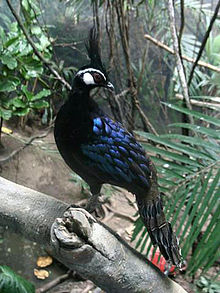Polyplectron
| Peacock-pheasants | |
|---|---|
 |
|
| male Palawan peacock-pheasant Polyplectron napoleonis |
|
| Scientific classification | |
| Kingdom: | Animalia |
| Phylum: | Chordata |
| Class: | Aves |
| Order: | Galliformes |
| Family: | Phasianidae |
| Subfamily: | Argusianinae |
| Genus: |
Polyplectron Temminck, 1807 |
| Synonyms | |
|
Polyplectrum (lapsus) |
|
Polyplectrum (lapsus)
The peacock-pheasants are a bird genus, Polyplectron, of the family Phasianidae, consisting of eight species. They are colored inconspicuously, relying on heavily on crypsis to avoid detection. When threatened, peacock-pheasants will alter their shapes utilising specialised plumage that when expanded reveals numerous iridescent orbs. The birds also vibrate their plume quills further accentuating their aposematism. Peacock-pheasants exhibit well developed metatarsal spurs. Older individuals may have multiple spurs on each leg. These kicking thorns are used in self-defense.
The systematics of the genus are somewhat unclear. Molecular research has revealed that peacock-pheasants are not genetically related to pheasants and only distantly to peafowl. Their closest allies are the Asiatic spurfowl and the crimson-headed partridge, endemic to Borneo. These three genera share the curious tendency for multiple metatarsal spurs. Though they are somewhat divergent morphologically, their skeletons are nearly identical.
The species of Polyplectron diverged at some time between, roughly, the Early Pliocene and the , or 5–1 million years ago. Polyplectron malacense and P. schleiermacheri form a basal radiation around the southern South China Sea together with P. napoleonis, as is confirmed by comparison of biogeography and mtDNA and D-loop as well as the nuclear ovomucoid intron G.
The relationships of the other forms are more poorly understood. P. germaini and P. bicalcaratum are similar in morphology and are nearly parapatric; the molecular data suggests that the latter is a symplesiomorphy. It would appear that P. germaini and P. katsumatae represent an early offshoot of the aforementioned basal radiation. The two montane-adapted species P. chalcurum and P. inopinatum are not derived from a single isolation event, and appear to have acquired more subdued coloration independently. A trend in this genus to lose—not gain—pronounced sexual dimorphism is better supported by biogeographical and molecular data than the alternate scenario.
...
Wikipedia
